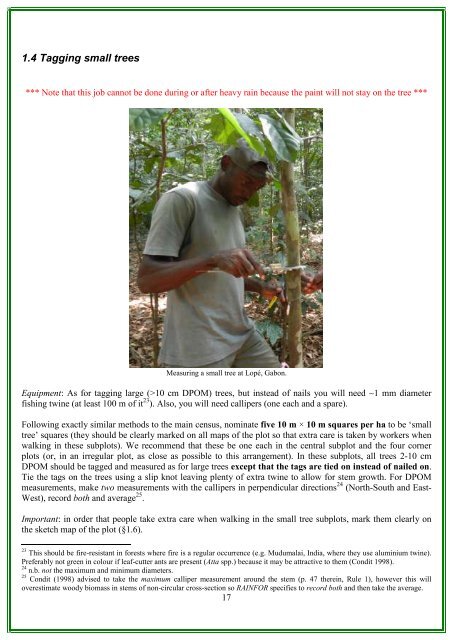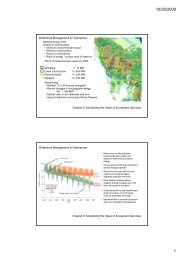RAINFOR GEM Intensive Plots Manual (pdf) - University of Oxford
RAINFOR GEM Intensive Plots Manual (pdf) - University of Oxford
RAINFOR GEM Intensive Plots Manual (pdf) - University of Oxford
- No tags were found...
You also want an ePaper? Increase the reach of your titles
YUMPU automatically turns print PDFs into web optimized ePapers that Google loves.
1.4 Tagging small trees*** Note that this job cannot be done during or after heavy rain because the paint will not stay on the tree ***Measuring a small tree at Lopé, Gabon.Equipment: As for tagging large (>10 cm DPOM) trees, but instead <strong>of</strong> nails you will need ~1 mm diameterfishing twine (at least 100 m <strong>of</strong> it 23 ). Also, you will need callipers (one each and a spare).Following exactly similar methods to the main census, nominate five 10 m × 10 m squares per ha to be ‘smalltree’ squares (they should be clearly marked on all maps <strong>of</strong> the plot so that extra care is taken by workers whenwalking in these subplots). We recommend that these be one each in the central subplot and the four cornerplots (or, in an irregular plot, as close as possible to this arrangement). In these subplots, all trees 2-10 cmDPOM should be tagged and measured as for large trees except that the tags are tied on instead <strong>of</strong> nailed on.Tie the tags on the trees using a slip knot leaving plenty <strong>of</strong> extra twine to allow for stem growth. For DPOMmeasurements, make two measurements with the callipers in perpendicular directions 24 (North-South and East-West), record both and average 25 .Important: in order that people take extra care when walking in the small tree subplots, mark them clearly onthe sketch map <strong>of</strong> the plot (§1.6).23 This should be fire-resistant in forests where fire is a regular occurrence (e.g. Mudumalai, India, where they use aluminium twine).Preferably not green in colour if leaf-cutter ants are present (Atta spp.) because it may be attractive to them (Condit 1998).24 n.b. not the maximum and minimum diameters.25 Condit (1998) advised to take the maximum calliper measurement around the stem (p. 47 therein, Rule 1), however this willoverestimate woody biomass in stems <strong>of</strong> non-circular cross-section so <strong>RAINFOR</strong> specifies to record both and then take the average.17





